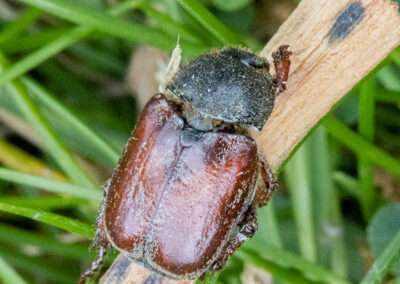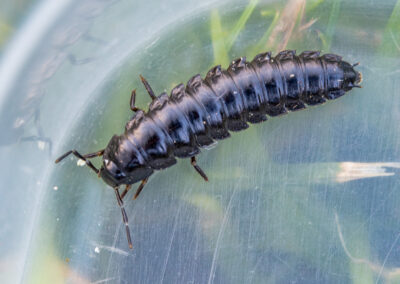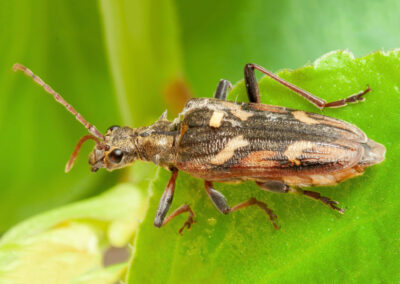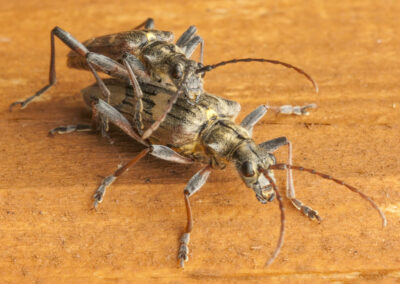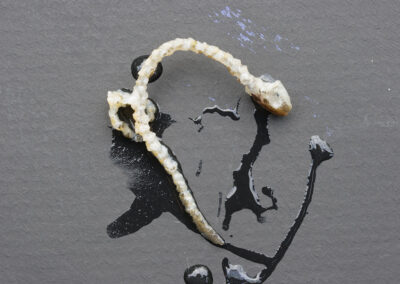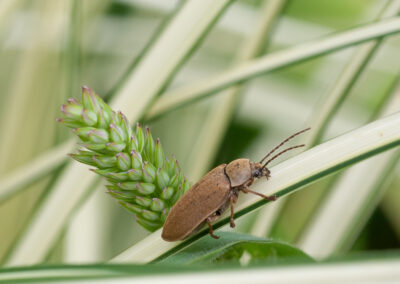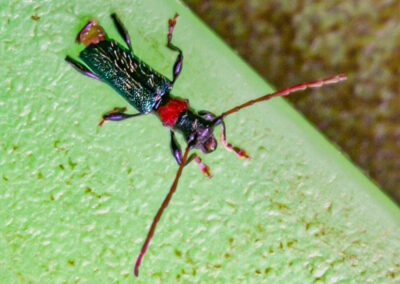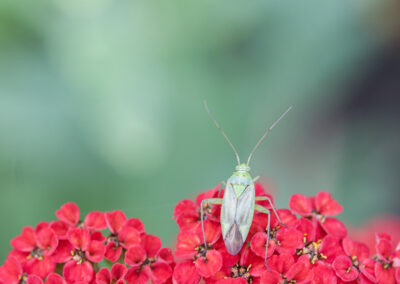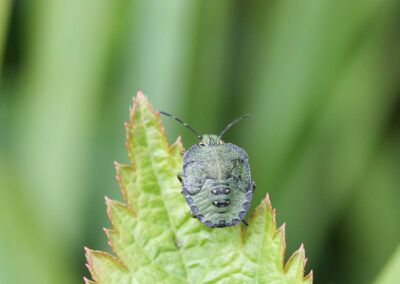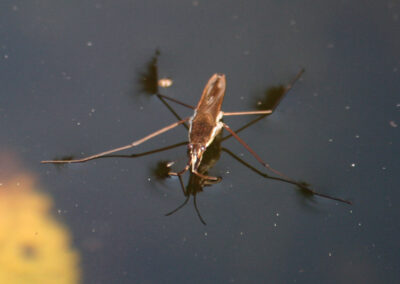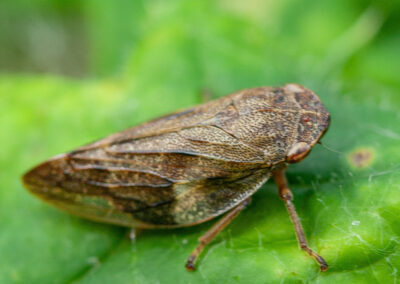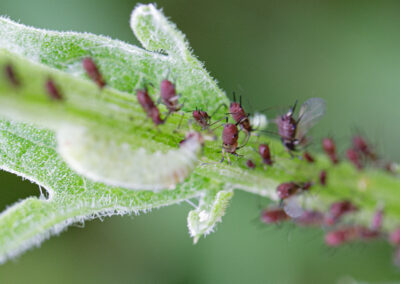Beetles & True Bugs
I have put these types of insects together as they are superficially similar. The term ‘true bugs’ is often used because ‘bugs’ has become a commonly-used generic term for almost any type of insect and has lost its meaning.
Beetles and Weevils belong to the order Coleoptera, whereas Bugs, Aphids, Hoppers and some other sub-orders belong to the order Hemiptera.
There are two main differences between these orders:
- almost all Coleoptera have mandibles, mouthparts for chewing, whereas Hemiptera have piercing mouthparts for sucking up nutrients.
- most Coleoptera undergo complete metamorphosis, having four stage of egg, larva, pupa and imago (adult), whereas Hemiptera have incomplete metamorphosis, with the stages egg, nymph (with several instar stages), adult.
Beetles & Weevils (Coleoptera)
Beetles
Beetles belong to the order Coleoptera, and there are about 400,000 species worldwide, of which 4072 species are resident in the UK; the UK number will change regularly as some disappear and others move in, partly due to climate change or those travelling here in plants and food.
Their forewings have evolved into hardened casings (elytra) to cover the hindwings (although a few species do not have these). Almost all species have biting mouthparts.
They undergo complete metamorphosis, going through the stages of egg, larva, pupa and adult.
Pachytodes cerambyciformis (Speckled Longhorn Beetle)
Pachytodes cerambyciformis (Speckled Longhorn Beetle)
Two-banded Longhorn (Rhagium bifasciatum) – rare colour form
Two-banded Longhorn (Rhagium bifasciatum) – rare colour form
Red-breasted Carrion Beetle (Oiceoptoma thoracica)
Red-breasted Carrion Beetle (Oiceoptoma thoracica)
Palmate Newt (Lissotriton helveticus) after Great Diving Beetles
Palmate Newt (Lissotriton helveticus) after Great Diving Beetles had finished with it.
Great Diving Beetle (Dytiscus marginalis) nymph
Great Diving Beetles (Dytiscus marginalis) attacking a newt.
Weevils
Weevils are beetles that belong to the superfamily Curculionidea, (most of them in the family Curculionidae) and there are about 60,000 species worldwide, of which 493 species are resident in the UK.
They are rarely longer than about 6mm. and their main distinguishing features are their long snout (rostrum) and most have elbowed (geniculate) antennae. Some have no wings, and some are good fliers.
They undergo complete metamorphosis, going through the stages of egg, larva, pupa and adult.
They feed mostly on plants, some species being very specific about the species of plant they feed on (particularly so as larvae), and some can cause great damage to crops.
Bugs, Hoppers, Aphids & other Hemiptera
There are about 75,000 species of the order Hemiptera worldwide, of which about 1830 species, in 63 families, are found in the UK. This order includes Planthoppers, Leafhoppers, Spittlebugs, Shield Bugs, Aphids, Thrips and Lice, amongst others.
The mouth parts are elongated into a rostrum, which is used to pierce plants (a few feed on animals) and suck juices from them. Saliva is pumped into the food source, some of which is dissolved by the salivary enzymes, and is extracted using a different pump mechanism. The rostrum is usually folded under the body when not in use, so is not easily visible.
Unlike beetles, the wing covers (elytra) of the Hemiptera overlap.
sub-order Heteroptera – Shield Bugs, Capsids, Backswimmers, Water Boatmen & Pond Skaters
Shield Bugs & Capsids
Although in different families, I have put these two together as they are superficially similar and may be confused with each other.
The mouth parts in Heteroptera grow from the front of the head.
There are 200 species of Miridae in the UK; most of them are herbivorous, but a few feed on aphids and other small, soft-bodied insects.
Common Green Shieldbug (Palomena prasina) – 3rd. instar nymph
Common Green Shieldbug (Palomena prasina) – 3rd. instar nymph
Common Green Shieldbug (Palomena prasina) – 2nd. instar nymph
Common Green Shieldbug (Palomena prasina) – 2nd. instar nymph
Backswimmers (Notonectidae), Water Boatmen (Corixidae) and Pond Skaters (Gerridae)
The Pond and River Skaters and Water Boatmen belong to the sub-order Heteroptera, along with the hoppers in the section above.
Pond Skaters (Gerris odontogaster) mating & Southern Hawker (Aes
Pond Skaters (Gerris odontogaster) mating & Southern Hawker (Aeshna cyanea) nymph
sub-order Auchenorrhyncha –
Froghoppers, Leafhoppers & Planthoppers
In Britain there are about 400 species of Auchenorrhyncha, worldwide about 42,000 known species. They can be distinguished from the other Hemiptera by:
- the mouthparts arise from the back of the head;
- the 3-segmented antennae are relatively short and bristlelike;
- the adult tarsi have 3 subsegments
They communicate with each other using acoustic signals generated by the ‘tymbal’ organ on the side of the abdomen, usually transmitted as vibrations through the plant they are on. In the UK these sounds are inaudible to humans, though in other countries, the cicadas (also a member of this sub-order) can be very audible.
Froghoppers belong to the family Cercopidae, and are also known as ‘spittlebugs’ or ‘cuckoo-spit’ insects.
- they have only a few stout spines on the rear tibia.
Some species’ nymphs live underground, most live in a frothy protective material (commonly known as ‘cuckoo spit’) which prevents them from drying out and offers some protection from predators. Whereas most sap-sucking insects feed on the nutrient-rich phloem of the plants, froghoppers feed on the more dilute xylem flowing up from the roots; to gain enough nutrition from this they have to drink a lot of it, and to get rid of the excess water from this, they produce the ‘spittle’.
Planthoppers can hop, but usually walk slowly instead, so as not to draw the attention of predators.
They can be distinguished from the other Auchenorrhyncha by two features:
- the bifurcate (“Y”-shaped) anal vein in the forewing,
- the thickened, three-segmented antennae, with a generally round or egg-shaped second segment (pedicel) that bears a fine filamentous arista.
sub-order Sternorrhyncha – Aphids, Scale Insects & Mealybugs
Aphids
There are about 4,000 species of aphids worldwide, of which … species can be found in the UK.
The mouthparts arise from between the front legs. They feed on plant sap, which is high in sugars but low in proteins, so they need to ingest large volumes of liquid to get a balanced diet; this leads to the production of a sticky secretion, ‘honeydew’ – well known to people who have parked their cars under some species of trees in the summer!
They overwinter as eggs, and in the spring, wingless females hatch; these usually reproduce asexually via ‘parthenogenesis’, which means that all the offspring are genetically identical to the mother. They give birth to numerous live nymphs(i.e. they are viviparous) every day, some of which will have wings which enable them to spread from plant to plant. In the autumn, some of the emerging nymphs will be male; these mate with the females, which then lay the eggs which will overwinter. This latter sexual reproduction stage is important in providing genetic variance in the species.
Aphids are often ‘farmed’ by ants for the honeydew that they produce. In return for this, the ants help to protect the aphids from predators, such as ladybirds.
Neozymus (Aulacorthum) circumflexum (Crescent Marked Arum Aphid)
Neozymus (Aulacorthum) circumflexum (Crescent Marked Arum Aphid)
Scale Insects & Mealybugs (Coccoidea)
There are about 170 species of these in the UK. The females of many species are wingless, and even legless, remaining attached to the plant host via their mouthparts, protected by either a scaly or fluffy covering. Like the aphids, they can reproduce parthenogenetically, and give birth to many live nymphs; these nymphs have legs until their first moult, enabling them to move to a suitable position for feeding.
Other Bugs
None yet found in Dernol.
















